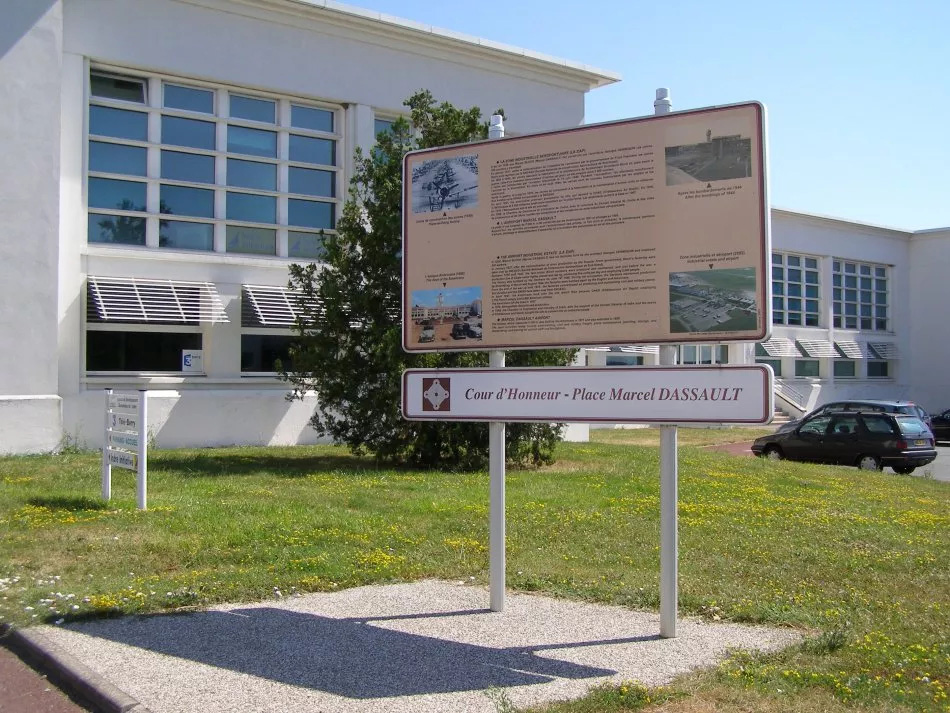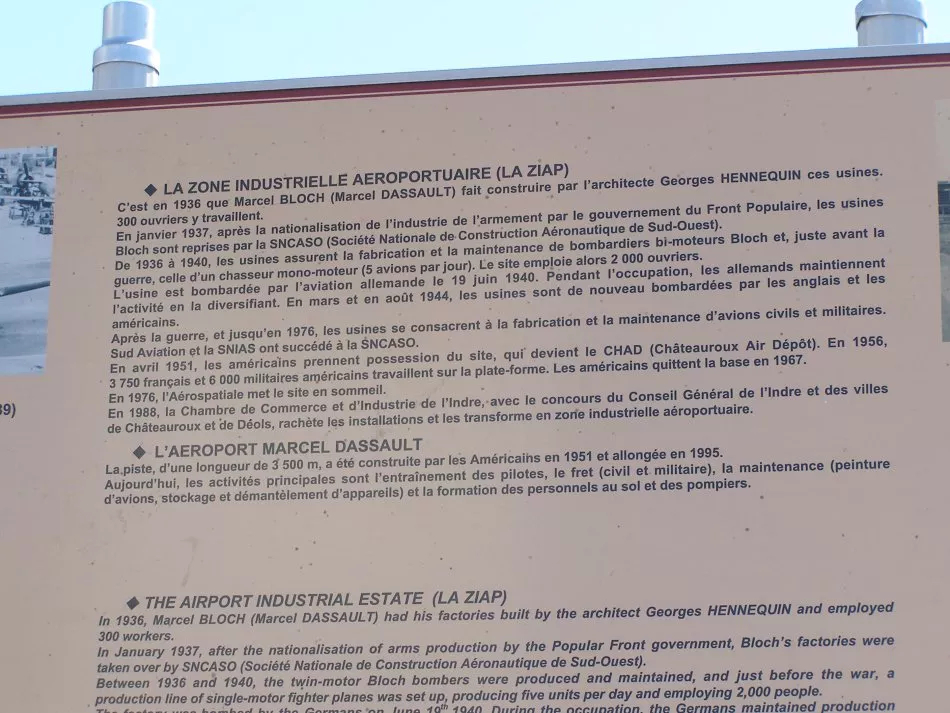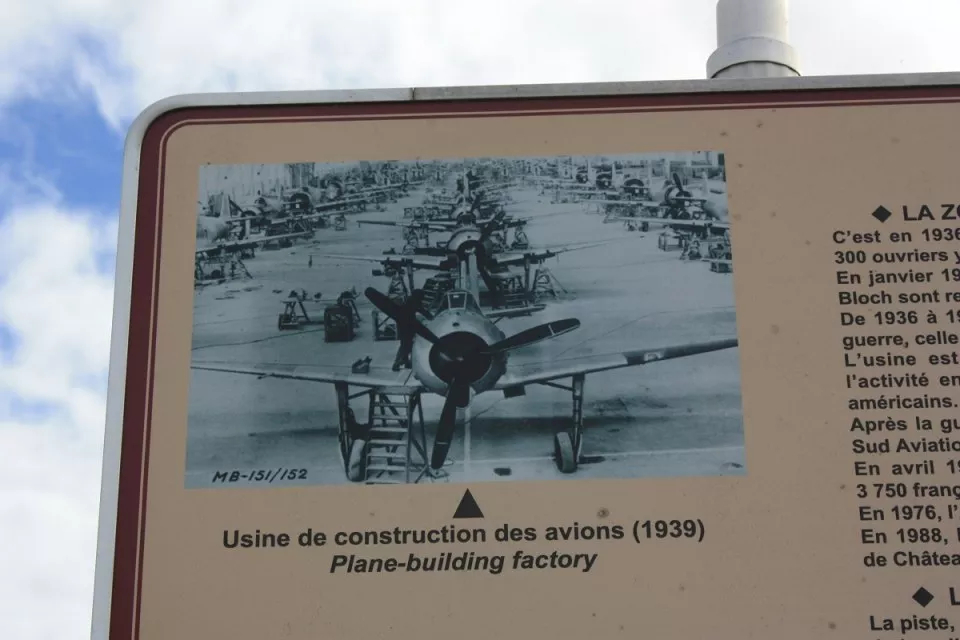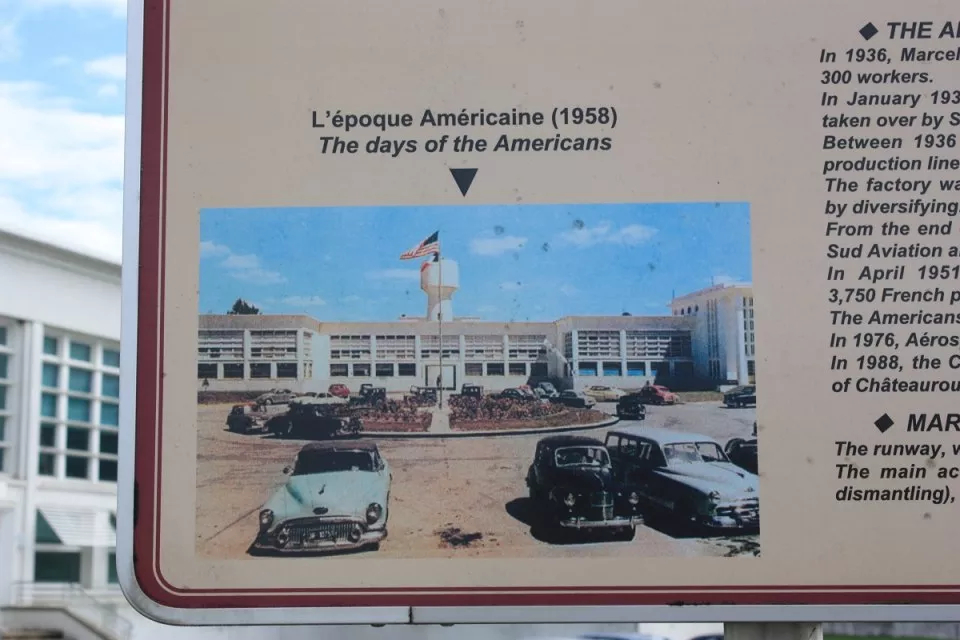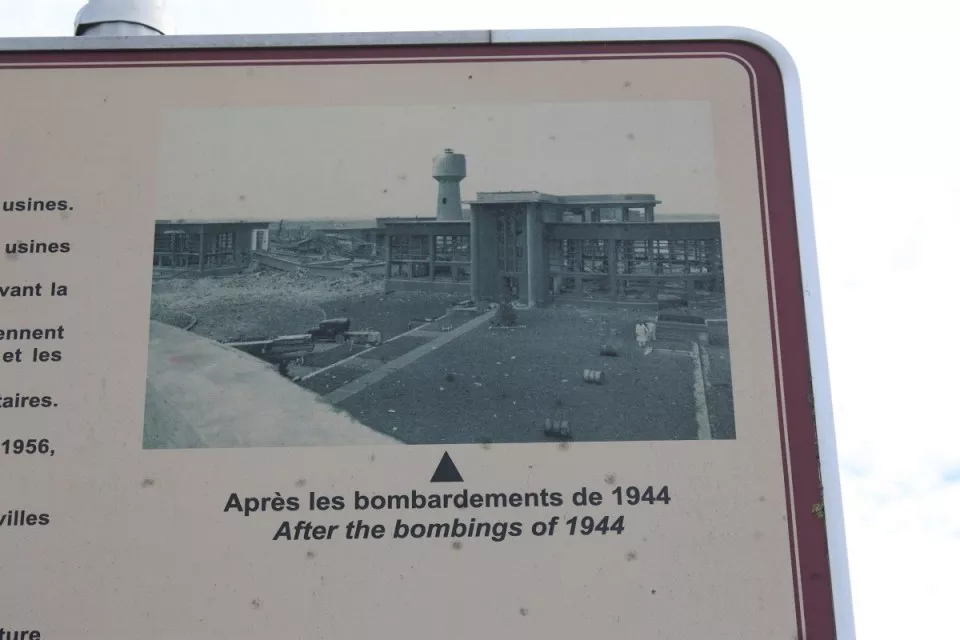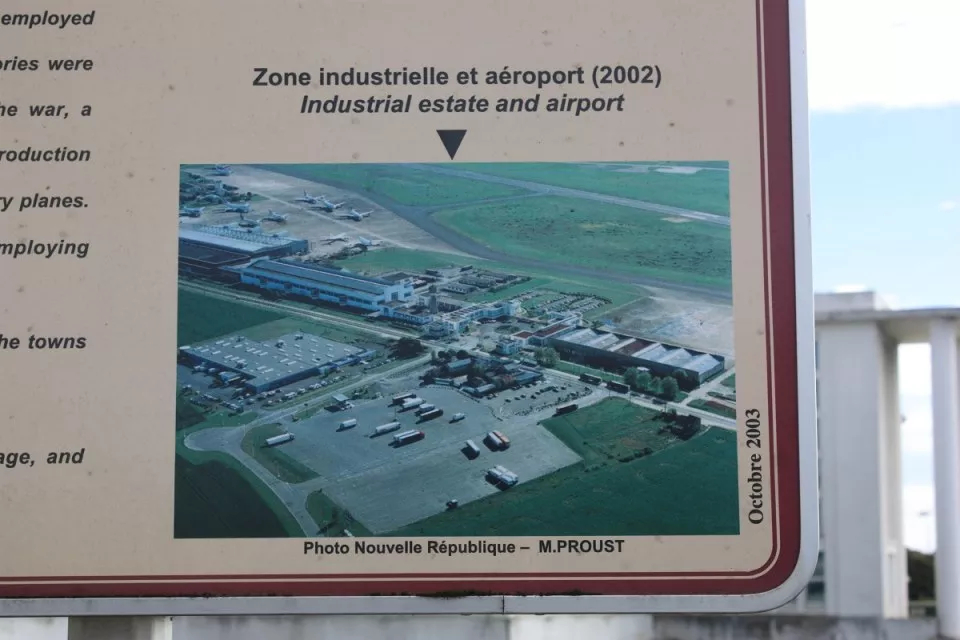History of Déols Airport Industrial Zone Info Sign
Details:
On the roadside, in front of the Aerocentre - Regional Center of Excellence building.
A large, rounded-rectangle, metal panel that is supported by two metal poles containing the history of the site. There are four pictures with captions on each corner of the panel flanking the history. The text is written in French and English.
During the Cold War, Châteauroux-Déols was a front-line base for the United States Air Forces in Europe (USAFE). The USAF base at Châteauroux-Déols actually consisted of two separate facilities about five miles apart, Châteauroux-Déols Air Depot (CHAD) and La Martinerie Airdrome. The base was home to some 8,000 Americans between 1951 and 1967.
The Châteauroux-Déols Air Depot (CHAD) became the largest depot in Europe to support USAFE and other NATO air forces. The mission of CHAD was to:
- Provide all necessary depot logistical support to USAFE and allied NATO Air Forces.
- Issue and control shipments of supplies to USAFE bases and Wings in France.
- Prepare USAFE requirements and requisitions to CONUS depots.
- Provide Depot-level maintenance to USAFE and NATO Aircraft.
- Provide supply and maintenance training for NATO personnel.
- Provide and supervice technical representatives requested by NATO countries.
- Assist Military Advisory Groups' logistical requirements.
- Maintain stocks of War Reserve Materiel for USAF and NATO requirements.
The Châteauroux-Déols commercial airport and La Martinerie storage site had excellent highway connections to the seaports at Bordeaux and La Rochelle, and excellent railroad service. The Marcel Bloch aircraft factory was leased by USAFE for depot level aircraft maintenance. As CHAD was developed as a joint-use NATO facility, its focus was on depot-level maintenance, taking over from Erding Air Depot in West Germany and Burtonwood Air Depot in the United Kingdom. CHAD also provided the flying facilities for Central Air Material Area, Europe (CAMAE).
Source of information: www.aerosteles.net, military-history.fandom.com
Source of photos: www.aerosteles.net
Monument Text:
♦ LA ZONE INDUSTRIELLE AEROPORTUAIRE (LA ZIAP)
C'est en 1936 que Marcel BLOCH (Marcel DASSAULT) fait construire par l'architecte Georges HENNEQUIN ces usines. 300 ouvriers y travaillent.
En janvier 1937, après la nationalisation de l'industrie de l'armement par le gouvernement du Front Populaire, les usines Bloch sont reprises par la SNCASO (Société Nationale de Construction Aéronautique de Sud-Ouest).
De 1936 à 1940, les usines assurent la fabrication et la maintenance de bombardiers bi-moteurs Bloch et, juste avant la guerre, celle d'un chasseur mono-moteur (5 avions par jour). Le site emploie alors 2 000 ouvriers.
L'usine est bombardée par l'aviation allemande le 19 juin 1940. Pendant l'occupation, les allemands maintiennent l'activité en la diversifiant. En mars et en aoùt 1944, les usines sont de nouveau bombardées par les anglais et les américains.
Après la guerre, et jusqu'en 1976, les usines se consacrent à la fabrication et la maintenance d'avions civils et militaires.
Sud Aviation et la SNIAS ont succédé à la SNCASO.
En avril 1951, les américains prennent possession du site, qui devient le CHAD (Châteauroux Air Dépôt). En 1956, 3 750 français et 6 000 militaires américains travaillent sur la plate-forme. Les américains quittent la base en 1967.
En 1976, l'Aérospatiale met le site en sommeil.
En 1988, la Chambre de Commerce et d'Industrie de l'Indre, avec le concours du Conseil Général de l'Indre et des villes de Châteauroux et de Déols, rachète les installations et les transforme en zone industrielle aéroportuaire.
♦ L'AEROPORT MARCEL DASSAULT
La piste, d'une longueur de 3 500 m, a été construite par les Américains en 1951 et allongée en 1995. Aujourd'hui, les activités principales sont l'entraînement des pilotes, le fret (civil et militaire), la maintenance (peinture d'avions, stockage et démantèlement d'appareils) et la formation des personnels au sol et des pompiers.
(The following translation is an online translation. Currently, we cannot provide the English transcription of what is on the panel as we don’t have the close-up shot of it yet.)
English translation:
♦ THE INDUSTRIAL AIRPORT ZONE (THE ZIAP)
In 1936, Marcel BLOCH (Marcel DASSAULT) had the architect Georges HENNEQUIN build these factories and employed 300 workers.
In January 1937, after the nationalisation of arms production by the Popular Front government, Bloch’s factories were taken over by the SNCASO (Société Nationale de Construction Aéronautique de Sud-Ouest).
Between 1936 to 1940, the factories manufactured and maintained twin-engine Bloch bombers and, just before the war, a single-engine fighter (5 planes per day). The site employed 2,000 workers.
The factory was bombed by the German air force on June 19, 1940. During the occupation, the Germans maintained the activity by diversifying it. In March and August 1944, the factories were again bombed by the British and Americans.
After the war, and until 1976, the factories are dedicated to the manufacture and maintenance of civil and military aircraft.
Sud Aviation and SNIAS succeeded SNCASO.
In April 1951, the Americans took possession of the site, which became the CHAD (Châteauroux Air Depot). In 1956, 3,750 French and 6,000 American soldiers worked on the platform. The Americans left the base in 1967.
In 1976, Aérospatiale mothballed the site.
In 1988, the Indre Chamber of Commerce and Industry, with the support of the Indre General Council and the cities of Châteauroux and Déols, bought the facilities and transformed them into an airport industrial zone.
♦ MARCEL DASSAULT AIRPORT
The runway, 3,500 m long, was built by the Americans in 1951 and extended in 1995. Today, the main activities are pilot training, cargo (civil and military), maintenance (aircraft painting, storage and dismantling) and training of ground personnel and firemen.

